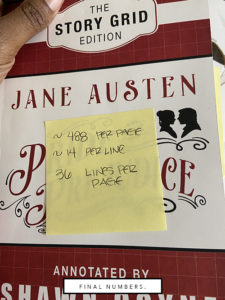Part of the story analysis process is capturing the scene word count. But this is hard to do when you’re reading a paperback and/or reading the ebook.
You can record the word count of a chapter in a few different ways.
- You can count the words in the chapter. Good luck!
- You can copy and paste the entire chapter into a word processing document (i.e., Word, Pages, Google Docs, etc.)
- You can use this little workaround that gives you an estimated count per unit of story.
The Steps
I’ll share the process without including estimate or proximate since I’ve mention this gives us an estimated word count. The process requires us to gather some information. We need to get three sets for numbers to determine the:
- Number of lines on a page,
- Words in a sentence, and
- Words per page.
This involves a little math, as covered in the video. It’s not bad, and it’s totally worth it. I’ll also show an example at the end of this post. So, grab a sheet of paper or some PostIt notes to capture your numbers.
Here we go!
First: Sample Pages. Select three random pages in your book. The pages should have a full page of text. (See the picture for an example.) I select my pages and add a PostIt note to each page around the beginning, middle, and end.

Second: Lines per page. Count the number of lines on your first page. Write the numbers down.
Example: 33
TIP: If you’re writing the numbers on a sheet of paper keep them separate by page. For example:
- Page 1: Lines 36
- Page 2: Lines 33
- Page 3: Lines 36
Third: Words per sentence. Find three full sentences on the first page. You want the sentences to run from the left to the right completely. I suggest skipping lines with a hyphenated word at the beginning or end. Like before capture each number.
Example:
- 14
- 11
- 15
Then add these numbers and divide by three. Write down the answer.
Example: (14+11+15)/3 = 40/3 = 13.3333
Four: Words per page. Multiple this number by the number of lines on the page. Which is the number we wrote from the Second step.
Example: 13.333 x 36 = 479.988
We’ll round this number up to 480. This gives us 480 words on your first sample page. (See how I did mine in the picture.)

Five. Repeat for other pages. Yay! You captured the estimated number of words on your first page. Repeat the process for your other sample pages.
Six. Final numbers. Now it’s time to get averages for all of your numbers. Like before I’ll include a final example. Here we go, you’re almost done.
- Approximate Lines Per Page. Number of lines per page. Add all of your averages for line counts and divide by three. Again, this is three numbers, one from each page.
- Example: (36 + 36 + 36)/3 = 108 / 3 = 36
- TIP: Be sure to count the number of lines on each of the sample pages. Most books have the same number of lines, but this isn’t always the case.
- Approximate words per sentence. Number of words per sentence. Add the final numbers from each page and divide by three.
- Example: (13 + 15 + 13)/3 = 41 / 3 = 13.6666 = 14
- TIP: I round up if the decimal is five or more.
- Approximate words per page. Number of words per page. Add all your totals and divide by three.
- Example: (480 + 528 + 456) / 3 = 1464 / 3 = 488
Save the Final Numbers
Take each of the numbers and record them. I usually write them on a PostIt and stick it to the front of the book (See the picture.)
Now, I’m sure your question is how does this work. Let’s take a look at my final example.

The Final Example
Okay that was a lot. Here’s the example from Chapter 23 of the book I’m analyzing—also shown in the video. We’ll find the estimate word count for the chapter. Here are my book numbers:
- 36 lines per page.
- 14 words per sentence.
- 488 words per page.
- Flip through the chapter and count the number of full pages and partial pages.
- 3 Full Pages
- 2 Partial Pages
- Start with the full pages. Multiply the number of full pages by your words per page.
- 3 full pages x 488 words per page = 3 x 488 = 1464 words
- Full pages = 1464
- Start with the partial pages. Count the number of lines and multiply by your words per sentence. For our example:
- Partial Page 1: 9 lines x 14 words per sentence = 9 x 14 = 126
- Partial Page 2: 31 lines x 14 words per sentence = 31 x 14 = 434
- Partial Pages = 126 + 434 = 560
- Add it all up. The totals from the full pages and the totals from the partial pages.
- 1464 words from full pages + 560 words from partial pages = 2024
- Chapter 23 has 2024 words.

Books Mentioned
- Sexy/Dangerous by Beverly Jenkins (affiliate link)
- The Story Grid Edition of Jane Austen’s Pride and Prejudice Annotated by Shawn Coyne (affiliate link)
Closing Remarks
This may seem like a lot. And it sort of is. But knowing the numbers helps when analyzing and evaluating your favorite novels and masterworks.
Have any questions? Let me know in the comments.
